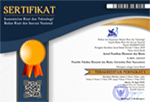The Effect of Environment Complexity and Resources on the Performance of SMEs Mediated By Business Strategy (Survey on Kasongan Pottery SMEs In Bantul Regency)
DOI:
https://doi.org/10.33633/jpeb.v7i1.4257Abstract
This study aims to analyze the effect of environmental complexity and resources on the performance of SMEs mediated by business strategy in Kasongan pottery SMEs. The population in this study were all SMEs pottery handicrafts in the Kasongan pottery center in Kasihan District, Bantul Regency, Yogyakarta. Total of 61 questionnaires have been returned and processed. The data analysis technique used was Partial Least Square (PLS) through SmartPLS 3.3.2 software. The research shows that environmental complexity has a positive and significant effect on performance of SMEs, resources have a positive and significant effect on performance of SMEs, environmental complexity has a positive and significant effect on business strategy, resources have a positive and significant effect on business strategy, and business strategy has a positive and significant effect on performance of SMEs. Also, it is found that environmental complexity has a positive and significant indirect effect on performance of SMEs through business strategy and resources have a positive and significant indirect effect on performance of SMEs mediated by business strategy. Keywords:Performance of SMEsEnvironment ComplexityResourcesBusiness strategyReferences
Aaker, D.A. 2001. Developing Business Strategies 6th Edition. John Wiley and Sons Inc., USA.
Arash Azadegan, Pankaj C. Patel, Abouzar Zangoueinezhad, Kevin Linderman. 2013. The Effect of Environmental Complexity and Environmental Dynamism on Lean Practices. Journal of Operations Management (Elsevier B.V) 31: 193-212.
Ashmos, Donde P. and Dennis Duchon. 2000. Organizational responses to complexity: the effect on organizational performance. Journal of Organizational Change Management 13: 577-594.
Aziz, Muhammad Abdul, Susilo Toto Raharjo, Amie Kusumawardhani. 2018. ANALISIS ORIENTASI STRATEGI UNTUK MENINGKATKAN INOVASI DAN KINERJA BISNIS (Studi Pada UKM Kasongan Kabupaten Bantul Daerah Istimewa Yogyakarta) 27: 1-20.
Benito, J. G., Rocha, D.R., dan Queiruga, D. 2010. The Environment as A Determining Factor of Purchasing and Supply Strategy: An Empirical Analysis of Brazilian Firms. International Journal Production Economics.
Carvalho, Carlos Eduardo, Carlos Ricardo Rossetto, & Miguel Angel Vedinelli. 2016. Strategic Orientation As A Mediator Between EnvironmentalDimensions and Performance: A Study of Brazilians Hotels. Journal of Hospitality Marketing Management Vol.25
David, Fred R. 2016. Manajemen Strategik: Suatu Pendekatan Keunggulan Bersaing-Konsep Edisi 15. Jakarta: Salemba Empat
Ferreira, Joao and Cristina Fernandes. 2017. Resources and capabilities’ effects on firm performance: what are they? Journal Of Knowledge Management Vol. 21 NO. 5 2017, pp. 1202-1217.
Gede, I Riana, Wibawa I Made Artha, Suparna Gede. 2020. The Influence Of Strategic Resources And Competitive Strategy. Russian Journal of Agricultural and Socio-Economic Sciences 174-185.
Ghozali, L., dan Latan, H. 2015. Partial Least Squares Konsep, Teknik dan Aplikasi Menggunakan Program SmartPLS 3.0. Semarang: Badan Penerbit Universitas Diponegoro.
Grant, Robert M. 2010. Contemporary Strategy Analysis Seventh Edition. John Wiley & Sons Ltd., UK.
Arrive Jean Tsitaire, Mei Feng. 2018. The complexity of the environment, management control and firm performance. Business Strategy and the Environment (Wiley) 1-8.
Lukas, B.A., Tan J.J., and Hult, G.M. 2001. Strategy Fit in Transitional Economies: The Case China’s Electronics Industry. Journal of Management.
Mahoney Joseph T, Yasemin Y. Kor. 2005. How Dynamics, Management, And Governance Of Resource Deployments Influence Firm-Level Performance. Strategic Management Journal (Wiley Interscience) 26: 489-496.
Michael A. Hitt, R. Duane Ireland, S. Michael Camp, Donald L. Sexton. 2001. Guest Editors' Introduction to The Special Issue Strategic Entrepreneurship: Entrepreneurial Strategies for Wealth Creation. Strategic Management Journal 22: 479-491.
Morgan P. Miles, Jeffrey G. Covin, Michael B. Heeley. 2000. The Relationship between Environmental Dynamism and Small Firm Structure, Strategy, and Performance. Journal of Marketing Theory and Practice: 63-78.
Phongpetra, Lichak & John, Lalit. 2011. Impact of Business Performance of Automobile Manufactures in Thailand. International Journal of Emerging Markets, 6 (11):17-37.
Porter, Michael. 1980. Competitive Strategy. United States: The Free Press A Division of Macmillan Publishing Co., Inc.
Sabihaini, Djumilah Hadiwidjojo, Djumahir, Mintarti Rahayu. 2012. Kompleksitas Lingkungan Dan Regulasi Pemerintah: Implikasinya Terhadap Kinerja Perbankan Di Jawa Timur. Jurnal Keuangan dan Perbankan 16: 455–471.
Sabihaini and Januar Eko. 2018. Non-Market Capability: Improve Performance Banking Industry. Journal of Engineering and Applied Sciences (Medwell Journals) 13 (Special Issue 10): 8142-8147.
Sholihin, M. & Ratmono, D. 2013. Analisis SEM-PLS dengan WarpPLS 3.0. Yogyakarta: Penerbit ANDI
Suardhika. 2011. Integrasi Sumber Daya Strategis, Orientasi Kewirausahaan, dan Dinamika Lingkungan Sebagai Basis Strategi Bersaing serta Pengaruhnya terhadap Kinerja Usaha (Studi pada UKM di Bali). Jurnal Aplikasi Manajemen 10: 212-227.
Thomas L Wheelen, J. David Hunger, Alan N. Hoffman, Charles E. Bamford. 2018. Concepts in Strategic Management and Business Policy: Globalization, Innovation and Sustainability. 15th. Pearson.
Downloads
Published
How to Cite
Issue
Section
License
The copyright of the received article shall be assigned to the journal as the publisher of the journal. The intended copyright includes the right to publish the article in various forms (including reprints). The journal maintains the publishing rights to the published articles.
This work is licensed under a Creative Commons Attribution 4.0 International License.


.png)









